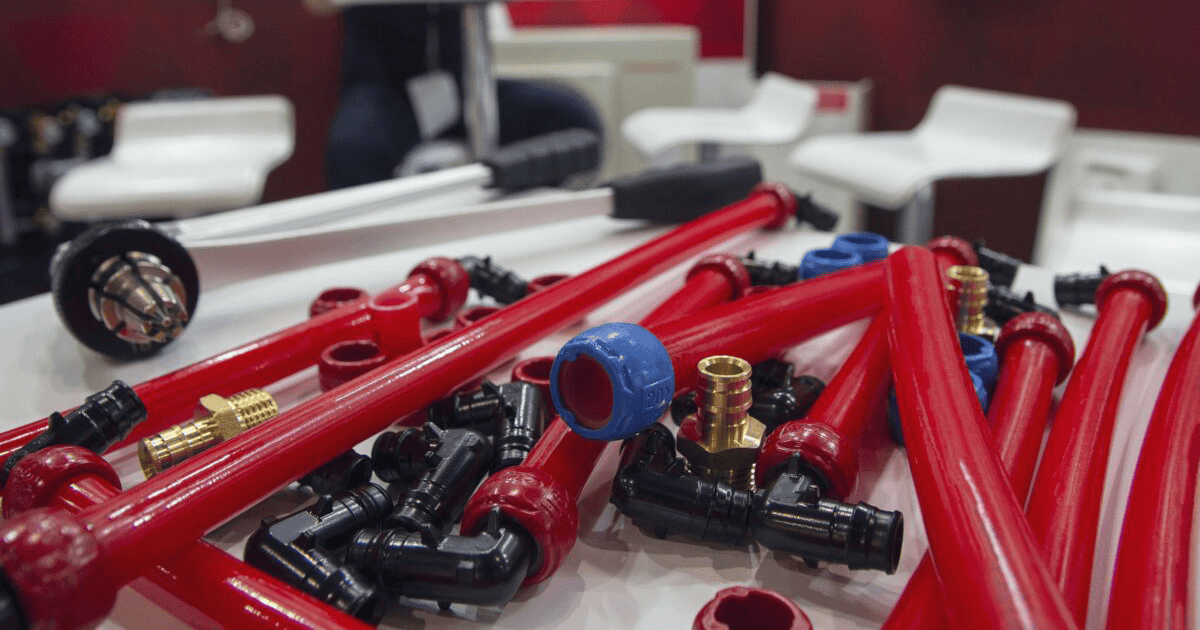How Long Do PEX Pipes Last? Uncovering the Facts About PEX Plumbing Systems
Imagine your body’s intricate network of veins that keep you alive and healthy. Now, imagine a similar system running through your home, ensuring the flow of water for all your daily needs. PEX pipes are like these veins, providing a reliable and efficient plumbing system for countless homes around the world. But how long can you expect these pipes to last? As with any part of your home’s infrastructure, knowing what you’re getting into is essential before deciding.
In this article, we’ll explore the lifespan of PEX pipes and what factors can affect their longevity. We’ll also weigh the pros and cons of using this plumbing system and provide insights on successful installation techniques. Whether building a new home or renovating an existing one, understanding PEX piping has been crucial in maintaining a safe and functional living space for years.
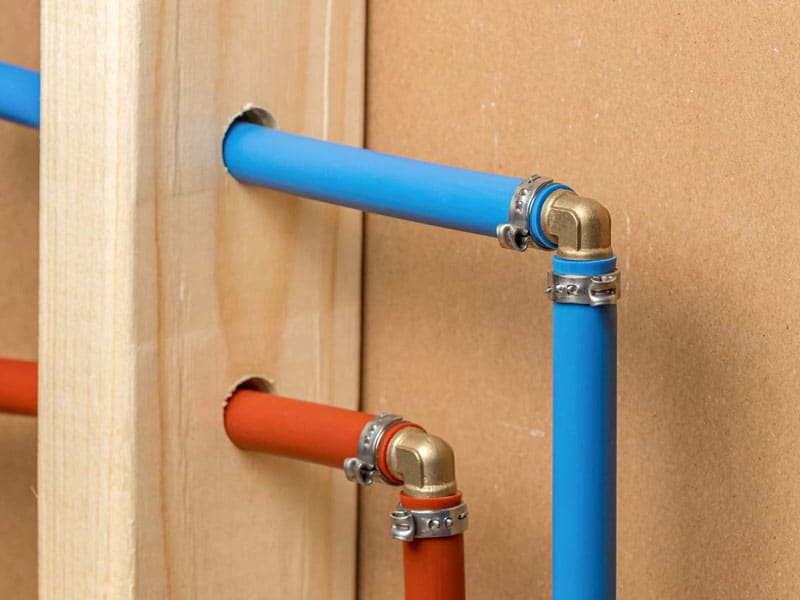
The Lifespan of PEX Pipes: How Long Can You Expect Them to Last?
If you’re considering PEX piping for your plumbing system, it’s essential to understand its lifespan. Factors affecting PEX pipes’ longevity include water quality and installation quality. While PEX pipes can last up to 50 years with proper maintenance, they have a shorter lifespan than copper and PVC pipes. Signs that your PEX plumbing system may need a replacement include leaks, decreased water pressure, and discolored water.
To extend the life of your PEX pipes, avoid exposing them to UV light or extreme temperatures and perform regular inspections. Different types of PEX tubing also have varying lifespans, so choosing the right style for your needs is essential.
Factors determining PEX pipe lifespan
To determine how long your PEX pipes will last, you should consider factors such as the quality of installation and exposure to hot water or high chlorine levels. The lifespan of PEX plumbing can range from 30-50 years, but it depends on various factors. For instance, the type of PEX used, the quality of installation, and other environmental conditions can all impact the lifespan of your pipes.
While PEX pipes are cheaper and easier to install than metal pipes, they may not have a longer life expectancy. It’s essential to weigh the pros and cons of PEX before using it for your home plumbing needs. In the next section, we’ll compare the lifespan of PEX pipes to copper pipes and PVC to help you make an informed decision for your home plumbing system. (Learn How To Paint Between Deck Boards)
Comparing PEX pipe lifespan to copper pipe and PVC
Get ready to reach the lifespan of PEX pipes with copper pipe and PVC, as you’ll want to know which material will best suit your plumbing needs.
First, let’s talk about PEX pipes. These pipes last up to 50 years or more, depending on their quality of installation. They’re cheaper and easier to install than copper piping, making them popular for residential, commercial, and industrial applications. However, their lifespan can be shortened by hot water or high chlorine levels in the water supply.
Copper or galvanized steel pipes have a longer lifespan (50-70 years) but are more expensive than PEX piping. PVC pipes have a life expectancy of up to 100 years and are cheaper than PEX and copper pipes but they cannot be used for hot water supply lines.
When deciding which type of pipe to use for your plumbing system, consider the pros and cons of each option based on your specific needs and budget. If you notice any signs that your PEX plumbing system needs replacement, such as leaks or reduced water pressure, it may be time to start planning an upgrade.
Signs that your PEX plumbing system needs replacement
So, you’ve been enjoying the convenience and durability of your PEX plumbing system, but have you noticed any signs that it may be time for a replacement? While PEX pipes can last up to 50 years with good maintenance, specific indicators may certain indicators may suggest otherwise. For instance, if you notice leaks or fitting failures in your water lines, this could signify that your PEX plumbing is reaching the end of its lifespan.
Additionally, if you see evidence of corrosion on crimp rings or fittings, this is another indication that your plastic pipe may need replacing. To help you identify other warning signs and determine whether it’s time to replace your PEX pipes entirely, check out the table below:
| Signs Your PEX Plumbing Needs Replacement |
|---|
| Leaks in water lines |
| Fitting failures |
| Corrosion on crimp rings or fittings |
| Unusual odors or tastes in drinking water |
If any of these symptoms sound familiar to you and persist despite attempts at repair or maintenance, then it may be time to consider replacing your entire PEX plumbing system. Doing so will ensure that your pipes continue functioning correctly without risking potential damage from aging components. But don’t worry – there are steps you can take to extend the life of your new PEX piping system! We’ll cover those next.
How to extend the life of your PEX pipes
If you want to ensure that your PEX plumbing system remains in good condition for years to come, there are several steps you can take. First and foremost, ensure the installation is done correctly by a licensed professional. This will help extend the lifespan of your PEX pipes and prevent any potential leaks or damage to your water supply.
Additionally, avoid exposing your PEX pipes to direct sunlight or UV rays, which can cause deterioration over time. It’s also important to keep an eye on the quality of your water supply and avoid using harsh chemicals that could potentially harm your PEX pipes.
Finally, consider regular maintenance checkups with a licensed plumber to catch any potential issues early on and prolong the life of your radiant heating and crosslinked polyethylene tubing. With these simple tips in mind, you can rest assured that your PEX plumbing system will remain functional and efficient for many years to come compared to copper pipe tubing.
The following section covers the lifespan of different types of PEX pipes.

The lifespan of different types of PEX pipes
The expected lifespan of various types of PEX tubing can vary based on their unique characteristics and material composition. PEX pipes are made from crosslinked polyethylene and are known for their durability, flexibility, and ability to withstand high temperatures.
While all PEX tubing is designed to last for several decades, the specific type you choose will impact its longevity. PEX-A is the most flexible, durable, and expensive, while PEX-B is affordable and good enough for most jobs. PEX-C is the cheapest but is stiff and at a higher risk of cracking with cold water flowing through them.
Compared to other plumbing materials like copper or CPVC plastic tubing, PEX piping offers a reliable plumbing solution that lasts up to 25 years under warranty, making it an attractive option for homeowners looking for a long-lasting solution. However, before choosing any piping material, it’s essential to weigh the pros and cons of each option carefully.
Pros and Cons of PEX Plumbing: Is It the Right Choice for Your Home?
If you’re considering using PEX piping in your plumbing system, there are several advantages to keep in mind. PEX pipes are easy to install and more affordable than copper piping. They’re also frozen and corrosion-resistant, drinking water safe, and meet NSF/ANSI Standard 61.
However, there are some potential issues to be aware of. For example, the shorter lifespan of PEX pipes compared to copper and the fact that they can’t be used outside or exposed to UV light. It’s essential to weigh the pros and cons carefully when deciding whether or not to use PEX piping for your project. Consider other options like PVC or copper if necessary.
Advantages of using PEX piping in your plumbing system
Using PEX piping in your plumbing system can offer numerous benefits. PEX pipes are easy to install, flexible, and less expensive than copper piping. They can be used for hot and cold water supply and drain lines in residential, commercial, and industrial applications.
PEX pipes are also suitable for radiant floor heating systems. With good maintenance, PEX pipes can last up to 50 years and are drinking water safe, meeting NSF/ANSI Standard 61. Fewer joints reduce the risk of leaks compared to copper piping.
Overall, if you want a cost-effective option that is easy to install and has a long lifespan with proper care, PEX piping may be the right choice for your plumbing system. However, there are still potential disadvantages and issues with PEX pipes that should be considered before making a decision. (Learn How To Connect Two Hoses Together)
Disadvantages of PEX pipes and potential issues
Despite their advantages, homeowners should be aware of potential PEX piping issues to decide on their plumbing system. While PEX pipes are generally durable and flexible, they should not be used outside as they are sensitive to UV light and can quickly deteriorate. Additionally, rodents can chew through PEX pipes, causing leaks and extensive damage to homes. Homeowners should also consider the lifespan of PEX piping, which is typically around 30-50 years and can be shortened by hot water or high chlorine levels.
Furthermore, some experts caution against using PEX for drinking water lines due to concerns about certain compounds leaking into the water over time. While PEX piping is becoming increasingly popular due to its affordability and ease of installation compared to copper piping, homeowners need to weigh the pros and cons before deciding on their plumbing system. Copper pipes may be a better option for those prioritizing durability over cost savings despite being more expensive and requiring more difficult installation processes. The following section will explore the differences between PEX vs. copper and PVC pipes in more detail.
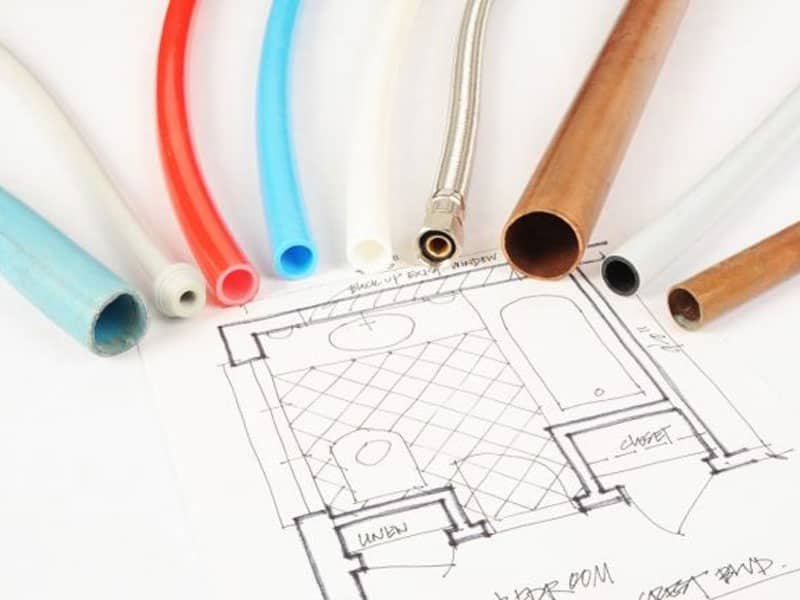
PEX vs. copper and PVC pipes: Which is best for your needs?
When considering the best option for your plumbing project, it’s worth comparing the benefits and drawbacks of PEX, copper, and PVC pipes. PEX pipes are flexible, easy to install, and cost-effective compared to copper piping. However, they have a shorter lifespan than copper pipes and are not recommended for areas exposed to direct sunlight or drinking water lines.
Copper pipes have a longer lifespan but are more expensive and require soldering during installation. PVC pipes are affordable but not as durable as PEX or copper piping.
When deciding between PEX, copper, and PVC pipes for your plumbing needs, consider their longevity, durability, flexibility, and cost-effectiveness. Understanding when you shouldn’t use PEX piping is crucial in deciding which type to use in your plumbing project.
Understanding when you shouldn’t use PEX piping
If PEX pipes aren’t suitable for your plumbing project, it’s important to consider alternatives like copper or PVC piping. While PEX is durable and flexible, it may not be ideal in some situations.
For example, PEX should not be used outdoors as it’s sensitive to UV light and can quickly deteriorate when exposed to sunlight. Additionally, PEX may not be the best choice if you have a rodent problem, as rodents can easily chew through it, causing leaks and extensive damage.
If you’re looking for metal pipes that will last longer than PEX, copper pipes have a 50-70 years lifespan, whereas PEX only lasts up to 50 years under warranty. However, copper is more expensive and requires soldering and sealing fittings with a torch, making installation more complex than the DIY-friendly PEX piping, which connects with easy-to-use fittings.
PVC and CPVC pipes are also suitable alternatives, but their lifespan depends on water acidity, while ABS pipes should last up to 100 years when properly installed. Making the best decision for your plumbing project involves weighing the pros and cons of each option based on your specific needs and budget constraints.
Making the best decision for your plumbing project
To make the best decision for your plumbing project, it’s essential to consider various factors such as durability, cost, installation ease, and specific needs. When choosing between PEX piping and metal pipes, one primary consideration is how long PEX pipe lasts compared to its alternatives. While copper pipes have a longer lifespan of 50-70 years, they are more expensive and require soldering during installation.
On the other hand, PEX piping lasts up to 25 years under warranty and is easier to install with fewer joints reducing the risk of leaks. However, its lifespan can be shortened by hot water or high chlorine levels in the water supply. Ultimately, weighing these pros and cons will help you make the right choice for your plumbing project.
It’s also worth noting that proper installation plays a significant role in how long does PEX plumbing last. In the next section about ‘pex piping for water supply: ensuring safe drinking water for your home,’ we will explore why PEX piping may or may not be suitable for drinking water applications without compromising safety measures.
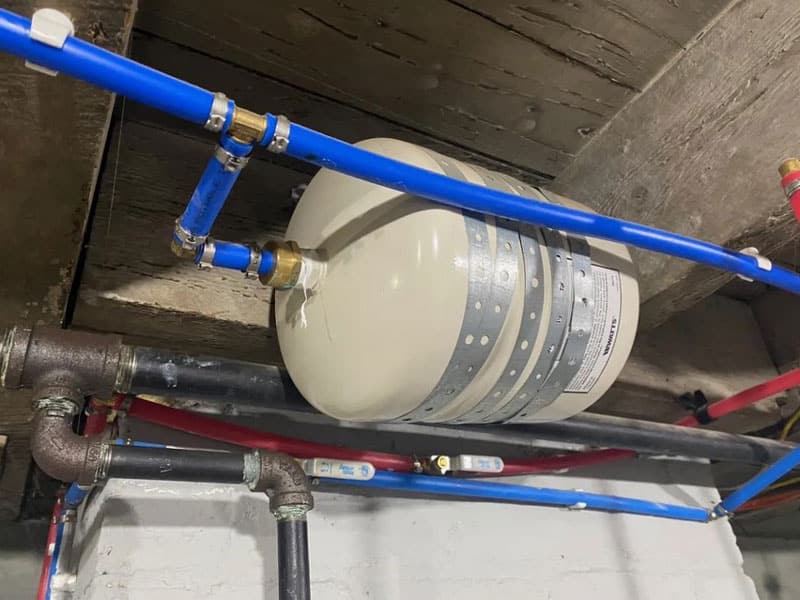
PEX Piping for Water Supply: Ensuring Safe Drinking Water for Your Home
When considering PEX piping for water supply lines, knowing the available types and their intended uses is essential. Understanding how PEX plumbing can affect drinking water quality is crucial for maintaining a safe water supply in your home. Proper installation techniques and maintenance can prevent leaks in PEX water lines.
Finally, properly integrating PEX pipes with other pipe materials ensures a reliable and efficient plumbing system.
Types of PEX pipes for water supply lines
You should know that there are three types of PEX pipes used for water supply lines:
- PEX-A, which is the most flexible and durable but also the most expensive
- PEX-B is the preferred choice of plumbers as it is affordable and good enough for most jobs
- PEX-C, which is the cheapest, but also stiff and at a higher risk of cracking with cold water flowing through them
While PEX pipes generally have an expected lifespan of up to 50 years with good maintenance, their quality of installation affects their longevity. It’s important to note that PEX piping doesn’t cope with freezing outdoor temperatures and can be easily damaged by rodents.
Studies show that certain compounds can leak into people’s drinking water from PEX pipes after a few years of exposure to heavy chloride. This highlights how important it is to understand how pex plumbing affects drinking water quality. (Read 6 Plant Saucer Alternatives)
How PEX plumbing affects drinking water quality
Understanding how PEX plumbing impacts the quality of drinking water is crucial. Certain compounds can start leaking into the water after prolonged exposure to high chloride levels. While PEX piping has been approved for use in drinking water systems, it’s important to note that its lifespan can be affected by hot water and high chlorine levels.
However, PEX piping offers benefits such as being freeze-resistant, easier to install, and having fewer joints than copper piping, reducing the risk of leaks. PEX piping is joined with fittings and may not last as long as copper plumbing. To ensure safe and clean drinking water from your plumbing lines, it’s recommended to regularly flush your system and avoid using harsh chemicals or cleaners.
The following section discusses installation tips for maintaining water supply safety.
Installation tips for maintaining water supply safety
Let’s explore some tips for installing PEX plumbing to ensure your water supply remains safe and clean. PEX pipes can last up to 50 years with good maintenance and are an easy-to-install option for hot and cold water supply in home plumbing.
Here are four tips to make sure you make the right choice when installing PEX pipes:
- Use PEX pipes instead of metal pipes to reduce the risk of corrosion.
- Install PEX piping away from potential sources of damage, such as rodents or UV light.
- Choose a high-quality fitting system to minimize leaks.
- Flush new PEX lines before using them to remove any debris accumulated during installation.
With these tips, you can confidently install PEX plumbing and maintain water supply safety. Speaking of which, let’s move on to how to deal with potential leak issues in PEX water lines.
How to deal with potential leak issues in PEX water lines
Solve any leaks in your PEX plumbing by spotting the source and sealing it with a suitable solution. PEX pipes are known for their durability but can still experience leaks for various reasons, such as poor installations or wear and tear. To address leak issues in PEX plumbing, you must first identify the source of the leak by inspecting joints and areas where the pipe may have been exposed to damage. Once identified, you can use a suitable solution, such as a crimp ring or push-fit fitting, to seal the leak.
It’s important to note that while PEX pipes are made to last up to 50 years, proper maintenance and installation play crucial roles in ensuring their longevity. Compared with copper piping, PEX is easier to install because it requires fewer connections and is more flexible †“making it ideal for radiant heating systems. However, depending on specific needs, installing PEX pipes alongside other pipe materials like copper may be necessary.
Using PEX pipes in conjunction with other pipe materials
You may be surprised to learn that using a combination of PEX pipes and copper piping can save you time, money, and headaches during your plumbing project. While copper pipes have a longer lifespan than PEX pipes, they’re more expensive and require soldering and sealing fittings with a torch.
On the other hand, PEX pipes are easier to install, more DIY-friendly, offer a main shutoff for each fixture, and are resistant to freeze-breakage. By using both types of piping in conjunction, you can take advantage of the benefits of both materials while minimizing their disadvantages.
However, it’s important to note that PVC or CPVC pipes shouldn’t be used with PEX plumbing due to chemical reactions between the two materials. PEX piping should last at least 50 years with good maintenance, while copper piping lasts 50-70 years, depending on usage and water acidity levels. With its flexibility and durability, and ability to withstand freezing temperatures without breaking or bursting as traditional metal pipes do, PEX makes an ideal choice for residential use as it reduces leak points which could lead to extensive damage over time.
Now let’s discuss PEX pipes for heating systems: performance and durability.
PEX Pipes for Heating Systems: Performance and Durability
If you’re considering using PEX tubing for your home heating system, it’s essential to understand its performance and durability. PEX pipes are commonly used in radiant floor heating systems for their flexibility and easy installation. They can also withstand temperature fluctuations and corrosive substances, making them a reliable choice for hot water supply lines.
However, following proper installation procedures and considering alternatives is essential if PEX isn’t suitable for your heating needs.
PEX tubing and radiant floor heating systems
Did you know PEX tubing is popular when considering radiant floor heating systems? It’s due to its flexibility and durability, with an expected lifespan of up to 50 years. PEX pipes are used in various applications, including under-slab heating and floor-warming systems. PEX piping is becoming increasingly popular due to its affordability, ease of installation, and resistance to corrosion and freeze.
Unlike copper piping, PEX is flexible and can be easily fitted around corners without elbow fittings. However, it’s important to note that PEX piping should not be used outside as it’s sensitive to UV light and susceptible to rodent damage. Understanding how PEX plumbing pipes last in hot and cold water applications is essential for homeownership maintenance.
Understanding PEX piping in hot and cold water applications
Now that we’ve discussed using PEX tubing in radiant floor heating systems, let’s dive into its application for hot and cold water supply lines. PEX piping has become popular due to its ease of installation, flexibility, and durability. Made from cross-linked polyethylene, it is color-coded for easy identification and can be joined with fittings without requiring soldering. Its flexibility makes it ideal for fitting around complex configurations during installation.
PEX pipes are cheaper than copper piping, easier to cut, corrosion-resistant, freeze-resistant, and safe drinking water, and meet NSF/ANSI Standard 61. They last up to 50 years or more under warranty when properly installed. While they cannot be used outside and are sensitive to UV light exposure and rodent damage, they have fewer joints than copper piping reducing the risk of leaks. This makes PEX plumbing last longer than other types of pipes, like copper, in specific applications where they can withstand temperature fluctuations and corrosive substances.
How PEX withstands temperature fluctuations and corrosive substances
Due to its crosslinked polyethylene material, PEX piping can withstand temperature fluctuations and corrosive substances. This provides flexibility and durability while also resisting mineral buildup and corrosion. PEX pipes are high-density plastic that withstands temperatures as low as -40°F without cracking or breaking. Compared to copper piping, PEX piping is also less likely to burst when exposed to freezing temperatures.
The material used in PEX piping comes with an expected lifespan of up to 50 years under warranty, making it a durable option for hot and cold water supply and drain lines. Additionally, PEX piping does not include toxic chemicals that can leach into drinking water over time, like other plumbing materials.
While the lifespan of PEX plumbing may be shortened by hot water or high chlorine levels, proper maintenance can help extend its longevity. PEX piping is also less expensive than copper piping and more accessible to install due to its flexible nature and easy-to-use fittings. Understanding how PEX withstands temperature fluctuations and corrosive substances makes it an attractive option for heating systems in homes and businesses. (Learn How To Get Rid Of Pachysandra)
Installation tips for PEX heating systems
Installing PEX heating systems can be made easier with these tips. Use a manifold to reduce the number of connections needed. Ensure proper insulation. Did you know that homes with radiant heating systems have lower energy bills by up to 30% compared to those with forced-air systems, according to a study by the National Renewable Energy Laboratory? PEX pipes are easy to install and less expensive than copper piping, making them ideal for residential, commercial, and industrial applications.
The crosslinked polyethylene material allows PEX pipes to withstand temperature fluctuations and bend around corners without requiring as many joints as copper piping. Following proper installation tips is important to ensure longevity in your PEX installations. Avoid exposure to UV light. Protect against rodent damage.
When considering alternatives for your heating needs, remember that copper piping may have a longer lifespan than PEX plumbing (50-70 years). However, it is also more expensive and requires soldering fittings with a torch.
When to consider alternatives to PEX for your heating needs
If you’re looking for heating options that are more durable and have a longer lifespan, it may be worth considering options for PEX piping. While PEX pipes can last up to 50 years with good maintenance, their lifespan can be shortened by hot water or high chlorine levels.
Additionally, PEX piping is less durable than copper and shouldn’t be used in areas exposed to direct sunlight or outside due to its susceptibility to rodent damage. Alternatives such as copper piping have a longer lifespan of 50-70 years and are more resistant to freeze-breakage, but they’re more expensive and require soldering and sealing fittings with a torch.
Ultimately, the decision between PEX and other alternatives will depend on your specific needs and preferences. Installing PEX plumbing: a guide to successful PEX pipe installation will provide further guidance on the benefits of using PEX pipes in residential, commercial, and industrial applications.
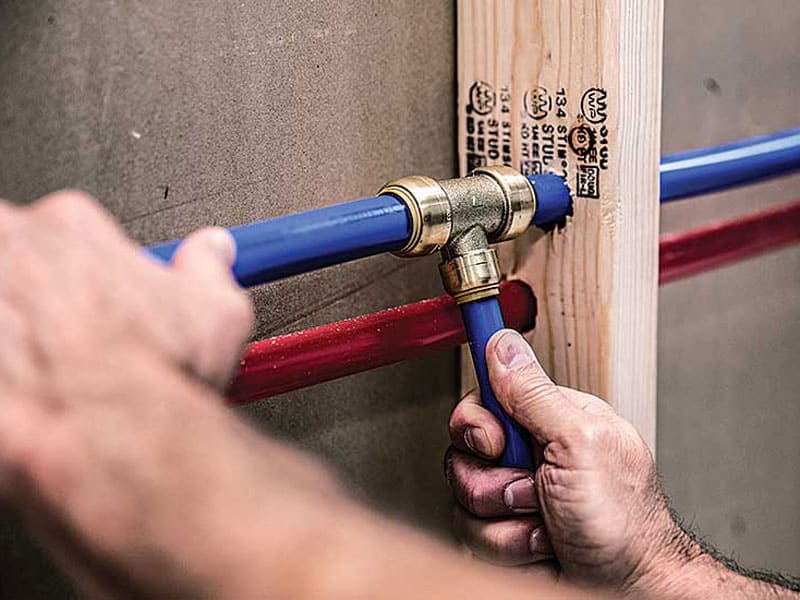
Installing PEX Plumbing: A Guide to Successful PEX Pipe Installation
You’ll need various tools and materials to successfully install a PEX plumbing system. These include PEX tubing, fittings, crimp rings, and a crimping tool. Understanding the different PEX fittings and connections is essential to ensure proper installation.
When installing PEX pipes in tight spaces or around corners, it’s crucial to use the proper techniques to avoid kinks or damage. Common installation mistakes can lead to leaks or other issues down the line. So, following best practices and maintaining your PEX plumbing system for long-lasting performance is essential.
Tools and materials needed to install PEX plumbing systems
When installing PEX plumbing systems, it’s essential to have the right tools and materials on hand. PEX pipes are made from crosslinked polyethylene and are flexible, making them easier to work with than copper pipes. To cut PEX tubing to size, you’ll need a pipe cutter designed for this type of material. You’ll also need a crimping tool to attach brass fittings securely. When purchasing fittings, ensure they’re compatible with the specific PEX tubing you use (PEX A, B, or C).
It’s easy to install a PEX plumbing system by snaking the tubing through finished walls with out cutting drywall and connecting fixtures with fewer joints than copper piping. While PEX piping doesn’t last as long as copper (30-50 years), proper installation can help maximize its lifespan. Understanding PEX fittings and connections is crucial for ensuring your system functions properly without leaks or other issues.
Understanding PEX fittings and connections
Now that you understand the tools and materials needed for installing PEX plumbing systems, it’s time to delve into understanding PEX fittings and connections. PEX piping is an excellent option due to its flexibility, durability, and resistance to freezing and corrosion. Not only does it last up to 50 years with good maintenance, but it also requires fewer joints than copper piping, reducing the risk of leaks.
Additionally, PEX is easier to install and cut than copper piping, making it more DIY-friendly. It’s made from crosslinked polyethylene and color-coded for easy identification based on its intended use. With a better understanding of PEX fittings and connections, you’ll be able to install your plumbing system in no time confidently! But how do you install PEX pipes in tight spaces or around corners?
How to install PEX pipes in tight spaces and around corners
Looking to install PEX pipes in tight spaces or around corners? Don’t worry; it’s easier than you think! PEX pipes are flexible and easily bent without elbow joints, making them ideal for navigating tricky angles and small spaces.
Made from cross-linked polyethylene, these pipes have a long expected lifespan of up to 50 years with good maintenance. Installing PEX pipes is also relatively easy compared to other plumbing systems. The flexibility of the pipes means they can be snaked through finished walls with out cutting drywall, reducing the amount of work required during installation.
With fewer connections required than copper piping, there is also a reduced risk of leaks occurring over time. So install those PEX pipes in tight spaces and around corners with ease!

